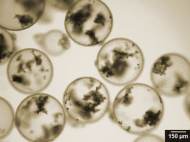Capsules for self-healing electronic circuits
 Researchers, from the University of Illinois at Urbana-Champaign, are also working on capsule additives designed to heal failures in lithium-ion battery electrodes, to prevent the short-circuiting that can sometimes cause a fire. Capsules filled with conductive nanotubes that rip open under mechanical stress could be placed on circuit boards in the areas that are important for device operation. When stress causes a crack in the circuit, some of the capsules could also rupture and release nanotubes to bridge the break.
Researchers, from the University of Illinois at Urbana-Champaign, are also working on capsule additives designed to heal failures in lithium-ion battery electrodes, to prevent the short-circuiting that can sometimes cause a fire. Capsules filled with conductive nanotubes that rip open under mechanical stress could be placed on circuit boards in the areas that are important for device operation. When stress causes a crack in the circuit, some of the capsules could also rupture and release nanotubes to bridge the break.
Previous research into self-healing materials has mostly focused on restoring mechanical properties after a damaging event. We already wrote about self-healing concrete and the University of Illinois researchers have already made self-healing coatings that can repair scratches and prevent corrosion on boats or car chassis. Now the group has brought the same techniques to the problem of restoring electronic properties.
“We want to address common failures in cell phones and other portable electronics,” says Paul Braun, a professor of materials science and engineering at the University of Illinois who leads the research project with Jeffrey Moore, a professor of chemistry, materials science, and engineering. These failures may become an even bigger problem as flexible electronics, which are subject to much more mechanical stress, become widespread, says Braun.
To make their self-healing material, Braun and Moore encapsulated carbon nanotubes inside polymer spheres about 200 micrometers in diameter each. They selected carbon nanotubes because of their high electrical conductivity and because their elongated shape does a good job of lining up to bridge gaps.
In their experiments (PDF), the researchers ripped the capsules apart and placed the resulting mixture between the tips of two electrical probes. The released nanotubes formed a bridge that completed the circuit between the two probes. Though the polymer itself isn’t conductive, there was a net positive increase in conductivity after it filled the rupture.
The researchers are currently developing ways to precisely position the spheres. Braun says the group has had a paper accepted describing the use of a technique called electrospraying to place the nanotube bubbles. The group is also working on more realistic tests for the capsules, including fracture studies in conductive materials.
With their further development, self-healing circuits could lead to lighter, cheaper and more efficient devices, particularly in critical, hard-to-repair situations. Currently, engineers build redundancy into such systems to guard against a total failure, but if the devices were able to heal themselves such redundancy systems wouldn’t be necessary. There is also potential for the technology to be used in batteries to restore the electrical conductivity of damaged battery electrodes, thereby preventing a short circuit that could lead to the battery exploding and also prolonging lifespans of rechargeable batteries.









Leave your response!